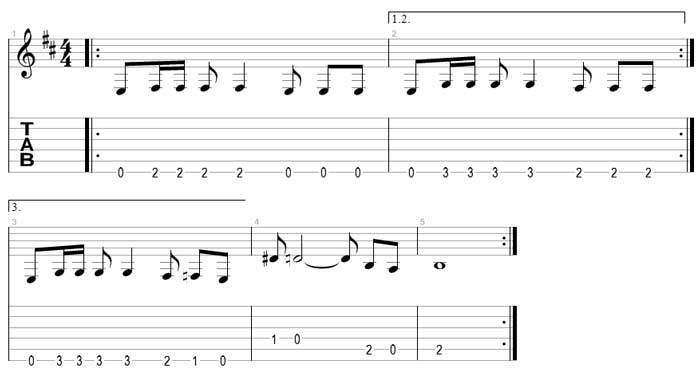This is the seventh lick in our ‘Licks and Riffs’ series and when we realized the lick would be number ‘007’ we couldn’t resist – it had to be the James Bond theme. If you have only seen the most recent two James Bond movies you may not recognize this riff but if you’ve seen any of the older movies you’ll recognize it instantly. This is a fun and very easy riff that any beginner can learn.
Tip: Use alternate picking on the sixteenth notes to get the rhythm right
Understanding alternate endings
If you don’t recognize the long lines above the staff they are ‘alternate endings’. Alternate endings are a simple way to repeat sections of music but changing some of the measures. In this case when you play the riff you start out by playing measures 1 & 2. You then repeat measure 1 (because of the repeat sign), repeat measure 2, repeat measure 1 again then skip ahead and play measure 3.
To understand why you play in this order have a look at the numbers above the staff. The first alternate ending bracket shows the numbers ‘1.2.’ which means that measure 2 is played on the first and second repeats. In other words, you play measures one and two (the first instance), then repeat measures one and two (the second instance). From there you repeat measure one. But this time you don’t play measure two again because it doesn’t ask for a third repeat. That’s why the second alternate ending bracket is written ‘3.’ – to play on the third repeat. After continuing on and finishing measure five the entire piece is repeated.
Getting the tone right
This riff sounds best when played on an electric guitar as that is what was used in the James Bond movies. After you learn the basics of the riff try to focus on how the riff sounds. Think about which pickup you should use. Maybe a bridge pickup would be a better choice than a neck pickup to get that sharp edgy sound. Experiment with where you pick the strings – closer to the bridge will give a more hollow sound and closer to the neck will give a bassy sound.
A technique you can use to make this riff sound more interesting is palm muting. Experiment by using different amounts of palm muting. Start by lightly muting the strings then gradually increase the palm muting until you almost can’t recognize the notes. Then you can decide what amount of palm muting sounds best.
Something else you can experiment with is distortion/overdrive. If you have an amp or pedal that lets you use distortion, try playing the lick with it. Experiment with different settings from low gain to high gain. Although the riff originally doesn’t use any distortion (ie: it is played clean), there’s no reason why you can’t add some in to change the feel of it.
Possibly the most important thing to keep in mind is to get the groove right – a James Bond riff should be played with suave, controlled groove! Try practicing with a metronome to make sure you’re playing this in time.








